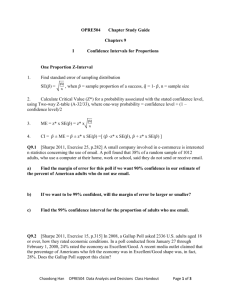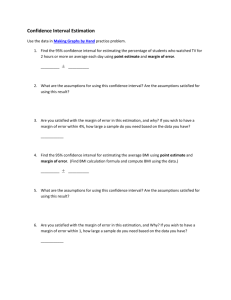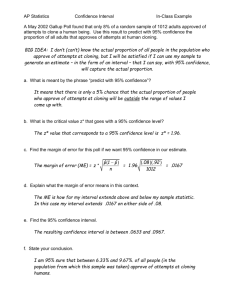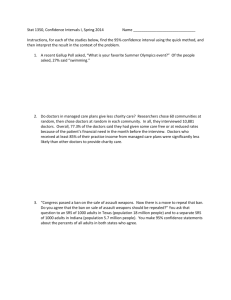evaluation of statistical reports
advertisement
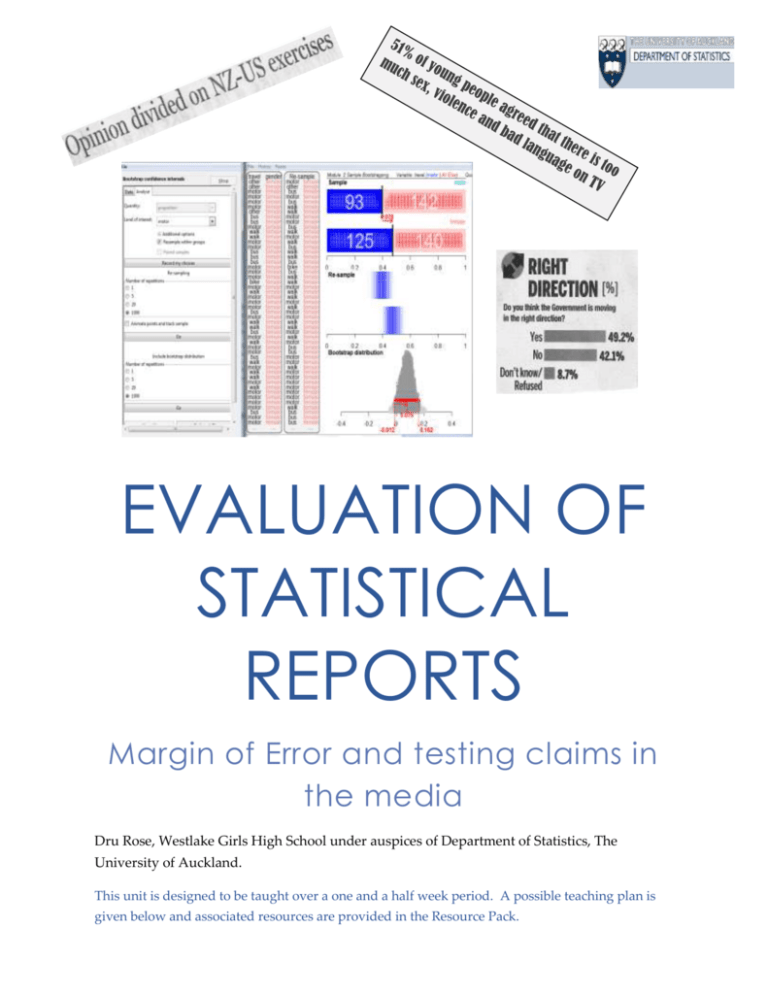
EVALUATION OF STATISTICAL REPORTS Margin of Error and testing claims in the media Dru Rose, Westlake Girls High School under auspices of Department of Statistics, The University of Auckland. This unit is designed to be taught over a one and a half week period. A possible teaching plan is given below and associated resources are provided in the Resource Pack. EVALUATION OF STATISTICAL REPORTS EVALUATION OF STATISTICAL REPORTS Margin of Error and testing claims in the media UNIT OVERVIEW Lesson 1 and 2 3 Topic Build the concept of margin of error Test claims involving a single poll% Comparison claims within one group Description Concrete activity exploring high variability of a sample proportion Use computer tool to develop 95% CI 1 and the “rule of thumb” Teaching Notes √𝑛 Calculating and interpreting 95% CIs and testing claims 2 x MoE rule of thumb 95% CIs for a difference within one group –testing claims involving this. Notes about activity objectives will be made in this panel. 4 5 6 7 Comparison claims involving 2 independent groups Political polls Concrete activity and computer tool leading to 1.5 × Av MoE “rule of thumb” Calculate and interpret 95%CIs Test claims made in media reports Power-point comparing methodologies Removal of the un-decided voters Key-Research Poll Activity Flow chart Safety of buildings activity References to resources used such as powerpoint slides will be referenced in this panel. Distinguishing the 3 types of claim. Working with tables. Summary Herald DigiPoll + worksheet Practice See new NZQA exemplar Activities Statistics Department, Auckland University 1 Dru Rose, WGHS EVALUATION OF STATISTICAL REPORTS LESSONS ONE and TWO (Where to break will depend on lesson length) ACTIVITY 1: Read a quick article to provoke the need to understand Margin of Error e.g. “Opinion divided on NZ-US exercises” Teaching Notes (A write-on sheet for this is in the Resource Pack) The reported Margin of Error is 3.6%. Ask students “What do you think this means?” (a student in the trial thought it was like measurement error in Physics) Probe current knowledge and thinking. ACTIVITY 2: A concrete activity to prepare students for the computer visualisation tools. Resource: Bags of “KareKare College “ data cards. Each pairs of students takes a sample of size 25 (×4 gives%) and finds the sample proportion who travel to school by car (motor on the cards) Sample proportions may be a new for students Media use percentages. Collect class results-explore the high variability of sample proportions (compared to previous work with means and medians) Show Wild’s animations. (see Resource Pack)- Always convert proportions to %s- in this topic. Point out higher variability for proportions in 30% to 70% range (bus, walk, motor) and much lower variability for proportions in the 10% and below range (bike, Animation showing a decrease in sampling variability with an increase in sample size for categorical data. (Wild, 2009) other) and by symmetry for the “90% and over” range. Statistics Department, Auckland University 2 Dru Rose, WGHS Sampling Error Powerpoint slides 1 to 4 EVALUATION OF STATISTICAL REPORTS Explain (or revise) bootstrapping (re-sampling from the sample) Use Sampling Error Power-point slides 1-4. The students do as many re-samples (with replacement) as needed to be able to follow the procedure in the iNZight bootsrapping module Teaching Notes Use of opaque bags for the sample helps ACTIVITY 3: reinforce the “looking “Developing the concept of a 95% CI and the Margin of Error” through rippled glass” metaphor for sampling Now use the iNZight bootstrapping module to repeat the re-sampling process: Import the 25 KareKare cards data from the Resource Pack into the bootstrapping module.(You can store this file in the data folder on your copy of iNZight). Drag the “Travel” heading into the variable box. Select “Analyse data”. Select “motor” as the variable of interest. Select “record my choices” Run the re-sampling at least once with the “animations” on, using the Use iNZight to develop the concept of Margin of Error as “half the length of a confidence interval” pause to show students how that the same card can be selected several times in the ‘with replacement’ sampling procedure. Turn the animations off, and run 20 re-samples, pointing out the horizontal blue band showing the variability in the sample proportions. Repeat with 1000 re-samples –point out the long width of the band of resample proportions, reinforcing the high variability of categorical data. Move on to the “bootstrap distribution” area at the bottom- Do one first- Ensure students understand that each vertical blue line represents a re-sample proportion. pointing out the sample proportion dropping down to make a circle on the scale at the bottom of the screen. Then 20- pointing out the shape, with the extremes occurring less oftenthen 1000, with the extremes corresponding to the very faint lines in the variability band of blue lines, as they occur only rarely. Statistics Department, Auckland University 3 Dru Rose, WGHS EVALUATION OF STATISTICAL REPORTS Ask students to state an interval describing where most re-sample proportions fall. Then add the confidence interval (where 95% of the re-sample Teaching Notes proportions fall)-Explain that the Margin of Error is half this interval; about 20% with this small sample of size 25. Stress that a confidence interval is a line on a scale (not the rectangle or the mound shape). You may choose to use the Fade facility but this only works if you have not re-sized any windows and it still leaves the rectangle showing above the line.. . A bootstrap confidence interval for proportions in the iNZight module ACTIVITY 4: “Developing the concept of 95% confidence” Develop the idea that a 95% confidence interval “captures the true proportion in the population” 95% of the time . Statistics Department, Auckland University 4 Dru Rose, WGHS EVALUATION OF STATISTICAL REPORTS Use the “Coverage Module” in iNZight: Import the whole population of KareKare College data. Teaching Notes Initially use a sample of size 25. One repeat, then 20, then 1000. Ask students to raise their hand when they see a red line-it will help . reinforce the idea that a confidence interval can miss the true parameter, but not often. Note: The iNZight module may not show exactly 95% coverage. Both the population and sample are very small in this simulation. ACTIVITY 5 Developing the 𝟏 √𝒏 “rule of thumb” for estimating a margin of error. 4 × sample size halves the width of the CIs Repeat the coverage module with a sample size of n=100 and hence halves the Margin of error halves to 10%. margin of error. Return to the bootstrapping module: Import the n=500 censusatschool sample (the variable of interest is still “travel” and motor). Obtain the confidence interval from 1000 resamples. The CI has a length of 9% and so the margin of error is 4.5% Not all media reports Hence demonstrate: quote a margin of 1 √25 =0.2=20%, and hence the 1 √100 𝟏 √𝒏 =0.1=10%, 1 √500 =0.045=4.5% error. “rule of thumb” for estimating a margin of error. The rule of thumb estimates the margin of error for a poll Return to the media article . “Opinion divided on NZ-US exercises”. Verify that 𝟏 = 3.65% is a good estimate of the √𝟕𝟓𝟎 reported margin of error. (note: you can now also see that the 850 below the graphic is an error). percentage in the 30% to 70% range at a 95% confidence level Poll %s outside this range will have a smaller margin of error (see Wild’s animation). Statistics Department, Auckland University 5 Dru Rose, WGHS EVALUATION OF STATISTICAL REPORTS ACTIVITY 6 “Calculating and interpreting a 95% confidence interval for a proportion “ Return to the media article . “Opinion divided on NZ-US exercises” and the write-on template. Complete Q2: Teaching Notes 2.Margin of Error: For poll %s of about 50% (between 30% and 70%) , margin of error ≈ 𝟏 √𝒏 at a …95%…… confidence level For poll %s below 30% and above70%, the margin of error is ……smaller……….. 95% of the time, the 95% confidence interval …captures…the true percentage in the population. Answers are also on “Sampling error power-point” slide 5 Note: MoE from large sample normal approximation: 𝑝̂ (1 − 𝑝̂ ) 1.96 × √ 𝑛 Students should draw the confidence interval picture: 39% 48% 44 % Note the change in the way we are now We can say, with 95% confidence, that the % of NZ children who travel to school by car is somewhere between ……39%…….and……48%………... interpreting a 95% confidence interval. Note: Bootstrap confidence intervals are not necessarily symmetric. However, when doing “rule of thumb” calculations to test claims, we will use symmetric confidence intervals: poll% ± margin of error The margin of error can be abbreviated by MoE in calculation working. Drawing a diagram seems to help students with both the calculation and interpreting the Encourage use of both a diagram and the square bracket notation: meaning of a confidence [39%, 48%] interval. Statistics Department, Auckland University 6 Dru Rose, WGHS EVALUATION OF STATISTICAL REPORTS ACTIVITY 7 Now complete Q3 on the write-on sheet, testing the claim in the NZ-US article: Teaching Notes “Opinion is fairly divided” 𝟏 Margin of error: (a) rule of thumb= √𝟕𝟓𝟎 = 3.65% (b) reported MoE =3.6% Sample % who support resumption of exercises =47.6% 95% confidence interval: (Draw a diagram) 44% “Sampling error power-point” slide 6” 51.2.% 47.6 % AS3.12 is a Statistical Meaning: With 95% confidence we can infer that the percentage of New Zealanders who support the resumption of military exercises with the USA is somewhere between 44% and 51.2% Judgement : Support could be as low as 43.9%, and so this confidence interval does not support a claim of 50% support as implied by the “fairly divided” statement in the article. Literacy standard (not formal inference). Being able to interpret the meaning of a confidence interval in context is therefore The Resource Pack contains a practice worksheet on calculating and using essential. 95% confidence intervals to test claims made in other media reports. LESSON THREE: Introducing Comparison Claims within one group . Starter ACTIVITY: Revision and consolidation of work to date Resources: Broadcasting Standards Poll report (Curia Research) and Worksheet 1 for this report. (See Resource Pack –answers supplied). Ask students to complete Q1 and Q2 and go over with class. Statistics Department, Auckland University 7 Dru Rose, WGHS EVALUATION OF STATISTICAL REPORTS LESSON THREE: ACTIVITY 2: Comparison within one group Develop the 2×MoE rule of thumb. Still using the Broadcasting standards poll, state the claim: Teaching Notes The group may be the whole target population “Young people are more likely to agree than disagree that there is too much sex, violence and bad language on TV” (as in this poll) or a sub- This claim involves two response options within the same poll. In a political poll: a In the absence of suitable software, we have to use a logical argument to develop the rule of thumb, but there is a tool to demonstrate that it works. Consider a situation with only 2 response options: Agree and Disagree (ie. group of it (see lesson 6) claim that National has a lead over Labour would be in this category. ignore the “don’t know/refuse “option) Suppose a poll produces the result exactly 50% agree and 50% disagree (hence a claim that this is the situation in the population) Use Sampling Error power-point slide 8 Suppose this poll has a margin of error of 4%. If we repeat the poll, we could get new sample results varying anywhere in the range 46% agree up to 54% agree (meaning the % who disagree would Note unit is “percentage also vary between 54% down to 46%). points” in confidence The difference between the new sample poll% who agree and % who disagree would be 8 percentage points but this would still be consistent with a 50-50 situation in the population. intervals involving differences (to ensure a distinction from %change involving a division as in We therefore need to obtain a poll % difference of more than 8 percentage % loss) points to disprove the claim that the population is evenly divided between agree and disagree. Note: MoE from large sample Hence we need a poll% difference of more than 2×the margin of error to support a claim that more people are likely to agree than disagree (or support one response option over another). Statistics Department, Auckland University 8 normal approximation 𝑝̂1 + 𝑝̂2 − (𝑝̂1 − 𝑝̂2 )2 1.96 × √ 𝑛 Dru Rose, WGHS EVALUATION OF STATISTICAL REPORTS Now complete “Broadcasting Standards Poll worksheet 1” Question 3. Note the wording of the interpretation of the 95% CI for this difference (see slide 8): [-1.2 perc. pts, 15.2 perc. pts] Teaching Notes “With 95% confidence, we can infer that more young people may Use Sampling Error disagree than agree by up to 1.2 perc.pts and more young people power-point slides 9 may agree than disagree by up to 15.2 perc. pts” and10 OR: “It is a fairly safe bet that the percentage of young people who The negative lower agree is somewhere between 1.2 percentage points lower and 15.2 limit implies that percentage points higher than the percentage of young people more young people who disagree.” may disagree than agree, the reverse of Now use the Coverage Spreadsheet to demonstrate that this the stated claim. 2×MoE rule of thumb does capture the true % difference back in Note the use of “and” the population, about 95% of the time: rather than or, since both options are possible Choose the one sample, 2 percentages option in the middle of the spreadsheet. Enter the 51% agree and 44% disagree from the Broadcasting Standards You can scroll down to show more of the confidence intervals if Poll, the reported margin of error 4.1% you wish. However, there is no slow speed option as in the and select the 2x Poll iNZight coverage module. (This spreadsheet was developed to Error Method. accommodate the need for a large sample size taken from a large population when looking at claims involving poll %s.) You will need to drag columns T and X to the left so that in/out and CIs show on the data Statistics Department, Auckland University 9 projector screen. Dru Rose, WGHS EVALUATION OF STATISTICAL REPORTS LESSON FOUR Comparison claims between two independent groups. Developing the 1.5×Average Margin of Error rule of thumb Teaching Notes ACTIVITY 1: A concrete activity to explain bootstrapping within two separate groups. Is the % girls who travel to school by car more than the % of boys? Resource: Bags of “KareKare College“ data cards. Each pair of students takes out a handful of cards (around 50 altogether) and sorts them into males and females. They count the number in each group (stress that the sample sizes do NOT have to be the same) and put each group in a separate bag. They note the percentage travelling by car (motor) for each group and then record the difference (female % - male%). It is important that the students do one pair of They then re-sample with replacement within each separate group, re-samples( female, noting the difference in re-sample %s (female % - male%). male) at a time and note the %difference each ACTIVITY 2 Using the iNZight bootstrap module: time. Import the censusatschool sample of size 500. (see Lesson 2) Re-sampling within groups in the iNZight module for confidence intervals for differences in proportions Statistics Department, Auckland University 10 Dru Rose, WGHS EVALUATION OF STATISTICAL REPORTS This time drag “travel” and then “gender” into the variable boxes. Select analyse data. The variable of interest is motor. Now click the + button for additional options and select the re-sample within groups option. Then record my choices. The red arrow shows that in the sample, 7.6% more females travel to school by car than males. Teaching Notes Remember to convert Do 20 re-samples. Explain to students that the blue lines are the sample proportions in each of the two separate samples, with each band of blue the proportions to % and encourage the lines showing the sampling variability within each group. The red arrow students to use %s in shows the difference (%female-%male) for each repeat of the re-sampling their discussions. procedure. Ask students what they think has happened when the arrow flips the other way. Then do 1000 re-samples, asking the students to raise their hand when they see the arrow flip (This occurs only occasionally since in general samples have a higher % of females). Now add the bootstrap distribution. 1 repeat shows the red arrow for the difference dropping down onto the scale at the bottom. Do 20 repeats and point out the negative differences on the scale for when there was a higher % of males travelling by car. Then 1000 and add the confidence interval. Sampling Error power-point slides 11 and 12 have the question, confidence interval and interpretation. “With 95% confidence, I can infer that the percentage of females who travel by car could be up to 1.2 percentage points less than the percentage of males who travel by car and up to 16.2 percentage points more.” OR: “It is a fairly safe bet that the percentage of females who travel by car is somewhere between 1.2 percentage points lower and 16.2 percentage points higher than the percentage of males who travel by car.” Statistics Department, Auckland University 11 Dru Rose, WGHS EVALUATION OF STATISTICAL REPORTS Developing the Rule of Thumb: Teaching Notes MoE for difference = 8.5% (half the bootstrap CI) MoE Males = 1 =6.5% MoE Females = √235 6.5+6.1 ) 2 Average MoE = ( 1 √265 =6.1% Sampling Error = 6.3% power-point 8.5% is between 1× Av MoE and 2× Av MoE (previous ideas) slide 10 So try: 1.5 x Av MoE = 1.5 x 6.3 =9% (a good approximation to the 8.5% Note: obtained by bootstrapping) MoE from large sample normal approximation We can show that this rule of thumb works about 95% of the time: Use the coverage spread-sheet: 𝑝̂1 (1 − 𝑝̂1 ) 𝑝̂2 (1 − 𝑝̂2 ) 1.96 × √ + 𝑛1 𝑛2 Choose the 2 independent samples option (the third choice) Enter the true %s for these populations as follows: True% females=38.7% True% males = 34.2% Enter sample sizes: Females: n=265 Males: n=235 The spreadsheet shows that this rule of thumb produces a CI which captures the true difference in population %s slightly more than 95% of the time. ACTIVITY 3 Broadcasting Standards Poll Worksheet 2 For Margin of Error Method choose: 1 √𝑛1 1.5 × ( + 1 )/2 √𝑛2 ×100% Can it be claimed that young women were more likely to agree than (Do not choose young men ? :-Sampling Error power-point Slide 14. (Note: Both limits 1.5×Average Poll error positive, so claim is supported) since the exact poll errors are unknown here) Statistics Department, Auckland University 12 Dru Rose, WGHS EVALUATION OF STATISTICAL REPORTS LESSON FIVE: Political Polls ACTIVITY 1 Show the power-point presentation on Political Polls. (see Sampling Error Resource Pack) Most political polls asking about the party vote in New Zealand Teaching Notes are for the “Decided Voters only”. Those people who are unsure or refuse to answer are usually removed before the analysis is done. Slides 10 and 11 in the However, Horizon Research uses a very different methodology. They include voters potentially leaning towards a particular party and only take out those refusing to answer or who cannot Political Polls powerpoint explain the “decided voters only” issue. or will not vote. They give their poll a different name: ”A Net Potential Vote Poll” (Horizon have put forward an argument in defense of their different methodology: see the Microsoft Word document entitled “Comparing Polls” in the Non-Sampling Error Resource Pack.) ACTIVITY 2 Using the 1.5 x Av MoE rule of thumb to compare *Key Research Poll Page 4: two separate political “party Vote” polls (2011 v 2012) Students should use Resources: (in Sampling Error Workshop Resource Pack) for claims 1 and 2 on 1. Herald on Sunday Key Research Poll Pages 2, 4* and 13 2. Political Polls Worksheet 1 (Answers in resource pack) (Note: The complete poll is provided in the resource pack) the “Valid%” columns the worksheet with sample sizes n= 794 in 2011 and n= 589 in 2012, removing the undecided voters. Removing the undecided voters is only necessary in “party vote” questions Statistics Department, Auckland University 13 Dru Rose, WGHS EVALUATION OF STATISTICAL REPORTS Teaching Notes Note: The “valid%” column is not provided for the “gender” table (June 2012 poll, Page 13) Students use the poll sample size n=700 for testing claim 3 LESSON SIX: Distinguishing the Three Types of Claim Resources: 1. Testing Claims Flow Chart 2. “Are our buildings safe to occupy?” Worksheet 3. Research NZ “Are our buildings safe to occupy?” report: Page 1with Table A + Tables 1-9 (pages 3,4,5 in full report) Additional report added to resource pack: Mondayising Waitangi Day and Anzac Day Activity 1: Students should initially focus on the statements in the Claim Column and use the procedural flow chart to help them to classify each . statement as either a “no-comparison” claim, a claim “involving a difference within the same group” or a claim ”involving a difference between 2 independent groups”. Students in the trial had the greatest difficulty recognising a comparison within the same group claim, eg.”…more confident than not confident…”, confusing it with a “no-comparison” claim. Check students have correctly classified each type of claim before they proceed with the rest of the sheet (see Answers in resource pack). You may need to spend time helping students to recognize key phrases implying a comparison claim. Statistics Department, Auckland University 14 Dru Rose, WGHS EVALUATION OF STATISTICAL REPORTS Activity 2 Teaching Notes Students should now complete the rest of the “are our buildings safe to occupy” worksheet. This involves extracting the required information from the appropriate table, recognizing the group(s) involved. Note: Categories “confident and “very confident” are combined and similarly “not confident” and “not at all confident” Encourage students to draw each confidence interval in addition to stating the interval in [,] notation and interpret it in words. LESSON SEVEN: Practice Summary Activities ACTIVITY 1: Resource: . 1. Herald Digipoll and graphics :”Labour makes big leap in polls” 2. Political Polls Worksheet 2 Nov 2102 Colmar This is a scaffolded activity covering both non-sampling errors; and margin of error and testing claims. Brunton Poll report is in resource pack. (Qs on Students should try and do it without using a “worry” questions sheet or the flow chart for helping to distinguish types of claims. Party vote , asset sales, (Answers in resource pack) govt depts.) ACTIVITY 2: You could use the Nov 2012 Colmar Brunton report to make your own similar activity. NZrepublic, trust in Additional resources may be added to resource pack in 2013. Statistics Department, Auckland University 15 Dru Rose, WGHS
